Portal:Environment/Selected picture
Usage
[edit]The layout design for these subpages is at Portal:Environment/Selected picture/Layout.
- Add a new Selected picture to the next available subpage.
- Update "max=" to new total for its {{Random portal component}} on the main page.
Selected pictures list
[edit]Selected picture/1 view - talk - edit - history

Selected picture/2 view - talk - edit - history

A false-color composite of global oceanic and terrestrial photoautotroph abundance, from September 1997 to August 2000. The picture shows the activity of photosynthesizing organisms in the biosphere. Many of these are used for ecosystem services which are natural processes relied upon by humans.
Selected picture/3 view - talk - edit - history

Recycling is the reprocessing of materials into new products. Recycling prevents useful material resources being wasted, reduces the consumption of raw materials and reduces energy usage, and hence greenhouse gas emissions, compared to virgin production.
Selected picture/4 view - talk - edit - history

Toyota Prius is one of the first mass-produced and marketed hybrid electric vehicles. Hybrid technology allows the vehicle to use both gasoline and electricity, thus reducing fuel consumption. It also reduces the amount of hydrocarbon emissions in the form of escaped gasoline vapour.
Selected picture/5 view - talk - edit - history

Mai Po Marshes is a nature reserve in Hong Kong. It is managed by World Wide Fund for Nature. The marshes have an area of about 1800 acres and is listed as a Ramsar site under Ramsar Convention in 1995. It provides a conservation area for mammals, reptiles, insects, and over 350 kinds of birds (including Saunders's Gull and a quarter of world's Black-faced Spoonbill population). It also has inter-tidal mangroves along with 24 traditionally operated shrimp ponds (called Gei Wai locally) to provide food for the birds. It receives 40,000 visitors annually.
Selected picture/6 view - talk - edit - history

Wind Power is the conversion of wind energy into more useful forms, usually electricity, using wind turbines. The energy is generated in the form of electricity by converting the rotation of turbine blades into electrical current by means of an electrical generator. Wind power is used in large scale wind farms for national electrical grids as well as in small individual turbines for providing electricity to rural residences or grid-isolated locations.
Selected picture/7 view - talk - edit - history

Selected picture/8 view - talk - edit - history
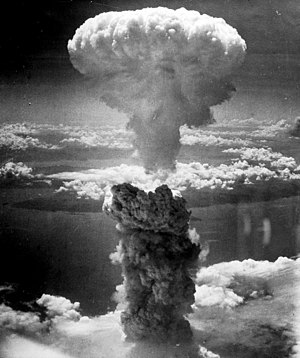
The detonation of nuclear weapons leads to the release of radioactive material into the environment. This radioactive material affects human health and the natural environment.
Selected picture/9 view - talk - edit - history
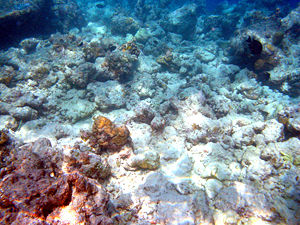
Coral bleaching refers to the loss of color of corals due to stress-induced expulsion of symbiotic unicellular algae. It can be caused by sedimentation, change in pH, change in water temperature, or pathogen infections. When coral bleaching occurs, the productivity of the coral reefs are lost.
Selected picture/10 view - talk - edit - history

Overpopulation is one of the reasons given for environmental impact as given by Paul R. Ehrlich's formula I = P x A x T where I is the impact, P is population A is affluence and T is technology. (See also:List of countries by population density.)
Selected picture/11 view - talk - edit - history
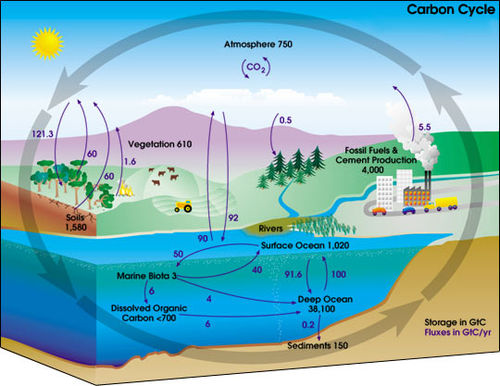
The carbon cycle is the biogeochemical cycle by which carbon is exchanged between the biosphere, geosphere, hydrosphere, and atmosphere of the Earth. Burning fossil fuels leads to the addition of extra carbon into the cycle over what naturally occurs and is a major cause of climate change.
Selected picture/12 view - talk - edit - history

The diversion of the Amu Darya and Syr Darya rivers for irrigation has shrunk the Aral Sea dramatically. The sea's surface area shrank by approximately 60%, and its volume by 80%. In 1960, the Aral Sea was the world's fourth-largest lake, with an area of approximately 68,000 km² and a volume of 1100 km³; by 1998, it had dropped to 28,687 km², and eighth-largest. Over the same time period its salinity has increased from about 10 g/l to about 45 g/l. As of 2004, the Aral Sea's surface area was only 17,160 km², 25% of its original size, and still contracting.
Selected picture/13 view - talk - edit - history

Irrigation is the artificial application of water to the soil usually for assisting in growing crops. In crop production it is mainly used to replace missing rainfall in periods of drought, but also to protect plants against frost. Additionally irrigation helps to suppress weed growing in rice fields. In contrast, agriculture that relies only on direct rainfall is sometimes referred to as dryland farming or as rain fed farming. Environmental problems such depletion of underground aquifers, ground subsidence, buildup of toxic salts on soil surface in areas of high evaporation, overirrigation and the possibility of water pollution.
Selected picture/14 view - talk - edit - history

An oil spill is the unintentional release of liquid petroleum hydrocarbon into the environment as a result of human activity. The term often refers to marine oil spills, where oil is released into the ocean or coastal waters. Oil can refer to many different materials, including crude oil, refined petroleum products (such as gasoline or diesel fuel) or by-products, ships' bunkers, oily refuse or oil mixed in waste. Spills take months or even years to clean up.
Selected picture/15 view - talk - edit - history
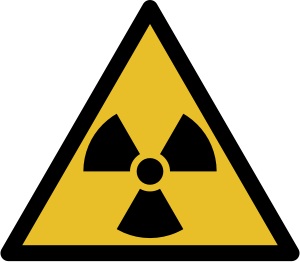
Radioactive contamination is the uncontrolled distribution of radioactive material in a given environment. It is typically the result of a spill or accident during the production or use of radionuclides (radioisotopes). Contamination may occur from radioactive gases, liquids or particles. For example, if a radionuclide used in nuclear medicine is accidentally spilled, the material could be spread by people as they walk around. Radioactive contamination may also be an inevitable result of certain processes, such as the release of radioactive xenon in nuclear fuel reprocessing.
Selected picture/16 view - talk - edit - history

ZENN (Zero Emission, No Noise) is a 2-seated car that runs solely on battery. It has a range of up to 60 km and does not exceed 40 km/h. The fuel economy is few cents per kilometer and the MSRP is $12,000.
Although the company is headquartered in Canada and the car manufactured in Canada, the vehicle was first introduced in United States because at the time of vehicle's design phrase, Canadian laws prevents this car to be driven on the roads. Since 2000, British Columbia has allowed ZENN cars on its roads.
Selected picture/17 view - talk - edit - history

Nanotechnology refers broadly to a field of applied science and technology whose unifying theme is the control of matter on the molecular level in scales smaller than 1 micrometre, normally 1 to 100 nanometers, and the fabrication of devices within that size range. Nanopollution is the result of waste generated by nanotechnology and has implications on the wider environment.
Selected picture/18 view - talk - edit - history

Smog is a type of air pollution; the word "smog" is a portmanteau of smoke and fog.
It is a problem in a number of cities and it harms human health. Ground-level ozone is especially harmful for senior citizens, children, and people with heart and lung conditions such as emphysema, bronchitis, and asthma. It can inflame breathing passages, decreasing the lungs' working capacity, and causing shortness of breath, pain when inhaling deeply, wheezing, and coughing. It can cause eye and nose irritation and it dries out the protective membranes of the nose and throat and interferes with the body's ability to fight infection, increasing susceptibility to illness. Hospital admissions and respiratory deaths often increase during periods when ozone levels are high.
Selected picture/19 view - talk - edit - history

Ecological footprint analysis measures human demand on nature. It compares human consumption of natural resources with planet Earth's ecological capacity to regenerate them. It is an estimate of the amount of biologically productive land and sea area needed to regenerate the resources a human population consumes and to absorb the corresponding waste, given prevailing technology. Using this assessment, it is possible to estimate how many planet Earth's it would take to support humanity if everybody lived a given lifestyle. While the measure is widely used, some also criticize the approach.
In 2003, the average biologically productive area per person worldwide was approximately 1.8 global hectares (gha) per capita. The US footprint per capita was 9.6 gha, and that of Switzerland was 5.1 gha per person, whilst China's was 1.6 gha per person. The WWF claims that the human footprint has exceeded the biocapacity (the available supply of natural resources) of the planet by 25%.
Selected picture/20 view - talk - edit - history
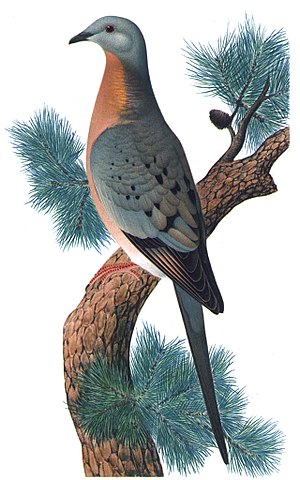
The passenger pigeon was a species of pigeon that was once the most common bird in North America. It is estimated that there were as many as five billion passenger pigeons in the United States at the time Europeans colonized North America. They lived in enormous flocks, and during migration, one could see flocks of them a mile (1.6 km) wide and 300 miles (500 km) long, taking several days to pass and probably containing two billion birds. The species had not been common in the Pre-Columbian period, until the devastation of the American Indian population by European diseases.
Over the 19th century, the species went from being one of the most abundant birds in the world to extinction. At the time, passenger pigeons had one of the largest groups or flocks of any animal, second to only the desert locust.
Some decimation in numbers occurred as a result of loss of habitat, when the Europeans started settling further inland. However, the primary factor emerged when pigeon meat was commercialized as a cheap food for slaves and the poor in the 19th century, resulting in hunting on a massive scale. There was a slow decline in their numbers between about 1800 and 1870, followed by a catastrophic decline between 1870 and 1890, at the end of which they were rare and beyond the point of recovery. 'Martha', thought to be the world's last passenger pigeon, died on September 1, 1914 in Cincinnati.
Selected picture/21 view - talk - edit - history

An animated image showing projections of stratospheric ozone concentrations if chlorofluorocarbons (CFCs) had not been banned. CFCs and other halogenated ozone-depleting substances are mainly responsible for man-made chemical ozone depletion. Since the ozone layer absorbs UVB ultraviolet light, its depletion is expected to increase surface UVB levels, which could lead to damage, including increase in skin cancer.
Nominations
[edit]Feel free to add pictures related to environmental issues to the above list. Other pictures may be nominated here.
